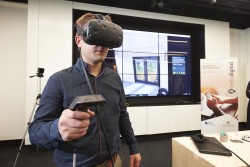In a few short years, modular offsite timber manufacturer Carbon Dynamic have garnered a reputation for cutting edge design and delivery. Managing Director Matt Stevenson, took part in a quick Q&A about how new technology is changing the shape of construction.
Q: Can you say a little about the creation of Carbon Dynamic and background to choosing an offsite modular approach using timber?
Matt Stevenson (MS):
Carbon Dynamic was established eight years ago in a highland farm steading. We are now based in a 4500m2 factory in Invergordon and we design and manufacture high-quality, beautiful timber modular buildings for the leisure and affordable housing markets having grown to a £4 million turnover and 45 permanent staff. We’re dedicated to delivering social, environmental and economic impact and do this by providing cost effective, low energy buildings using locally-sourced healthy and sustainable materials, and believe offsite manufacturing is the best way to control the quality of both process and product.
Q: What level of construction efficiencies are improved through the modular approach as compared with traditional build – either thermal, durability or manufacturing quality benefits?
MS: Construction time is easier to predict and safer due to lack of weather influence. Time on site is minimised resulting in less disruption to neighbours. Material waste is reduced as this is controlled from a central location, quality of workmanship is easier to control and oversee – all resulting in better airtightness and thermal efficiency. It’s a safer working environment for staff than rural building sites.
Q: What are Fit Homes? What is the concept designed to achieve and where does it sit in the wider creation of flexible living and the development of ‘smart’ homes?
MS: The ‘Fit Homes’ concept is a technology-enabled smart house that promotes wellbeing and preventative health solutions up to and including end of life care. Residents benefit from digital health and assisted living technologies in a way that has not been possible before. The concept supports residents to take charge of their own wellbeing. At the same time they can meet their health needs through a system of innovative technology and design. They will be able to both self-manage their support and have enhanced face-to-face social interaction. Fit Homes is a home for life, not just an end-of-life solution. The technology enables young people to maintain a sense of wellbeing and morphs as the person responds to the physical and mental changes that life brings.
Q: The use of VR/AR technology is exciting and grasping many architect’s and manufacturers imaginations – how important is this to the future development of construction and the wider role of digital technology in the timber sector?
MS: We have been developing our virtual reality (VR) tools to create photorealistic experiences. This allows for our designers and clients to visualise a project before a single piece of wood has been cut. This is an invaluable step in our design process as it can inform so much of the design, we have successfully run a co-design workshop with over a 100 participants on our Fit Homes project which had a great impact on the design process. In partnership with Sublime we have been looking at developing augmented reality (AR) as a tool for manufacture. The Augmented Worker system will be designed to drive greater certainty, safety, efficiency
and sustainability through five key areas – co-design, digital job guidance, progress monitoring, safety guidance and asset management. This will allow jobs to be delivered on-time, and within budget, whilst also giving a greater level of collaboration and communication between teams.
To view the rest of this article in Offsite Magazine please visit: Offsite Magazine









